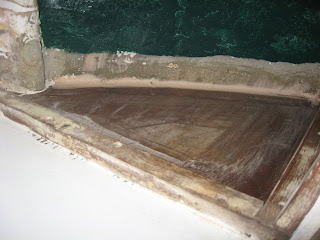Between 1957 and 1970 Cheoy Lee produced approximatley 133 folkboats originaly sold as the the Offshore 25, better known as the Frisco Flyer.
There were three versions of this small blue-water boat. 91 in all wood and 42 in Fiberglass with wood. There were 55 Type I's and II's and 78 of the Type III's. The Type I (aka the Pacific Clipper) was an all wood boat, had a mast that was stepped through the deck, a traditional folkboat fractional rig and a smaller cabin. The Type II's had a larger teak trunk cabin and a masthead rig. The Type III's had a larger teak dog-house cabin, some "standing" headroom and a masthead rig stepped on deck. The earlier Type III's were solid teak built onto a fiberglass hull and the later Type III’s (1966-1970) were made entirely out of fiberglass with teak paneling.
This boat, Yard # 1507 is one of approximatley only 30 Type III's left. It was out of the water for the previous 16 years when I got it and then about another 5 more while I rebuilt it. It was an empty, cracked hull when given to me and needed a complete restoration/refit. It took about five years of long nights and weekends of working outside under a tarp, in the garage or in the boat during cold winter nights, wet rainy afternoons and everything in between. The occasionally eager assistant on the project was my four (now ten) year old daughter who can have this boat as soon as I convince her mother to get another one. This blog is the record of all the work that "we" have done to the boat as well as some other somewhat related events with friends and family. Eventually, this will be put together in a book which will stay with the boat.
There were three versions of this small blue-water boat. 91 in all wood and 42 in Fiberglass with wood. There were 55 Type I's and II's and 78 of the Type III's. The Type I (aka the Pacific Clipper) was an all wood boat, had a mast that was stepped through the deck, a traditional folkboat fractional rig and a smaller cabin. The Type II's had a larger teak trunk cabin and a masthead rig. The Type III's had a larger teak dog-house cabin, some "standing" headroom and a masthead rig stepped on deck. The earlier Type III's were solid teak built onto a fiberglass hull and the later Type III’s (1966-1970) were made entirely out of fiberglass with teak paneling.
This boat, Yard # 1507 is one of approximatley only 30 Type III's left. It was out of the water for the previous 16 years when I got it and then about another 5 more while I rebuilt it. It was an empty, cracked hull when given to me and needed a complete restoration/refit. It took about five years of long nights and weekends of working outside under a tarp, in the garage or in the boat during cold winter nights, wet rainy afternoons and everything in between. The occasionally eager assistant on the project was my four (now ten) year old daughter who can have this boat as soon as I convince her mother to get another one. This blog is the record of all the work that "we" have done to the boat as well as some other somewhat related events with friends and family. Eventually, this will be put together in a book which will stay with the boat.
She still has plenty more to go but for now, Jackaroe has been in the water for a couple years now and thats all that matters...
To see past projects, use the links below.
Questions and comments to Matthewearlgarthwait@gmail.com
To see past projects, use the links below.
Questions and comments to Matthewearlgarthwait@gmail.com
Monday, September 27, 2010
Saturday, September 25, 2010
Reinforcing/tabbing bulkheads....
Back in May, I sanded, vacuumed, washed with solvent, then laid down some mat and cloth fiberglass. A couple layers on all the corners under the seating and cabinets. I wanted to paint these areas but thought it would be a good idea to reinforce them first.




After all the glass was in, sanded, vacuumed, wiped down with solvent, and finally given a couple of coats of Interlux one part poly. Now the hull will be sealed from water intrusion, inside and out!




After all the glass was in, sanded, vacuumed, wiped down with solvent, and finally given a couple of coats of Interlux one part poly. Now the hull will be sealed from water intrusion, inside and out!
Removing trim/molding around cabinhouse....
While working on fixing some leaks in the cabin house roof, I found that some of the old fiberglass either didnt cover all the way down to the trim piece and was letting water in or it used to reach all the way but has since cracked and water has crept in. I decided the best thing to do was to take the molding off to make sure the seal around the cabin house roof were 100% all the way around. The pieces didn't come off easily, and I wish I saved those corner pieces!
Subscribe to:
Posts (Atom)